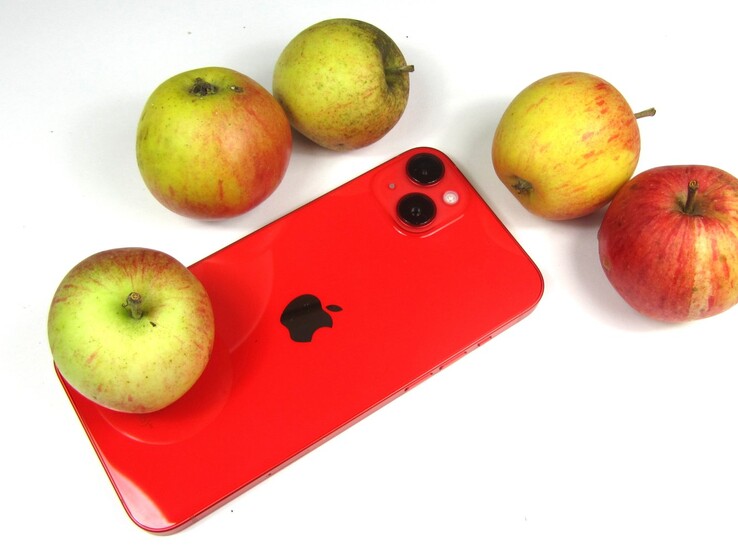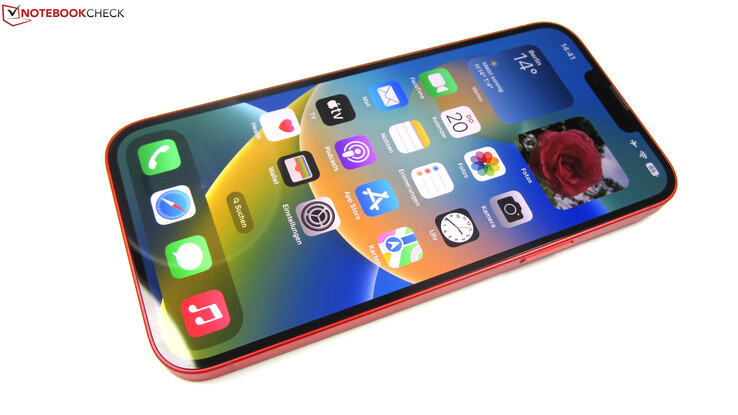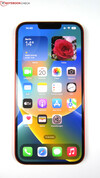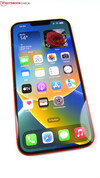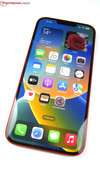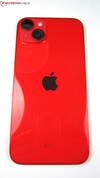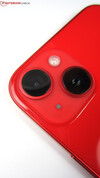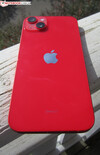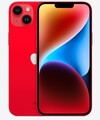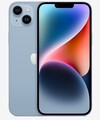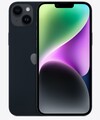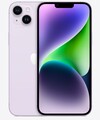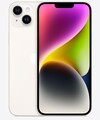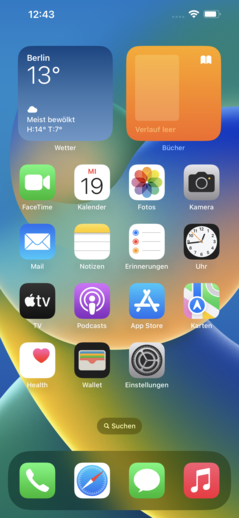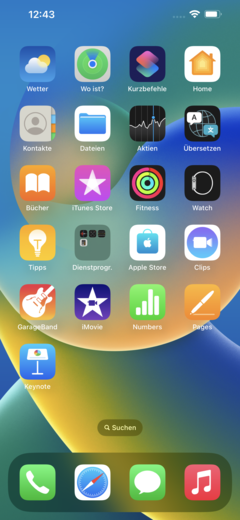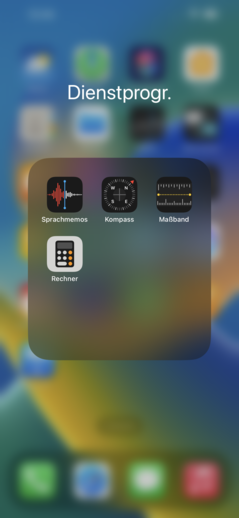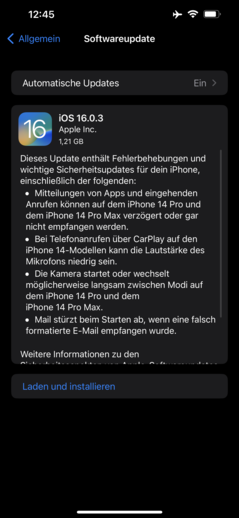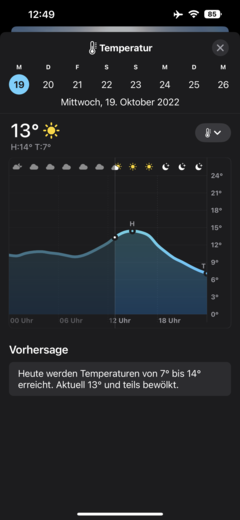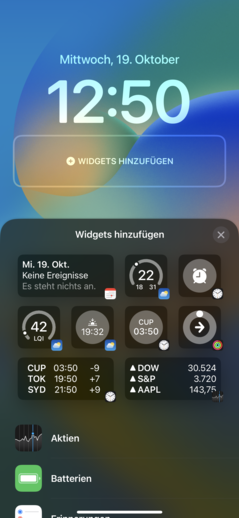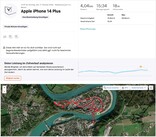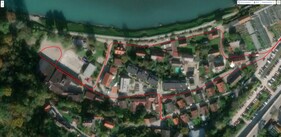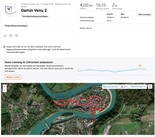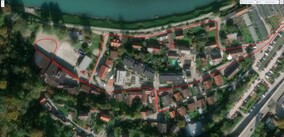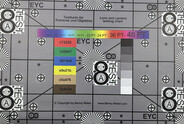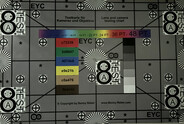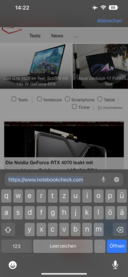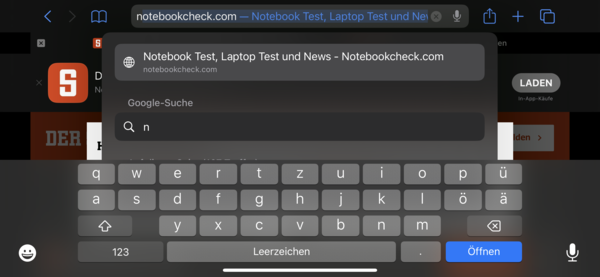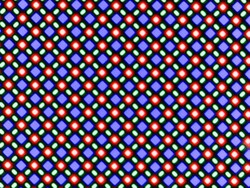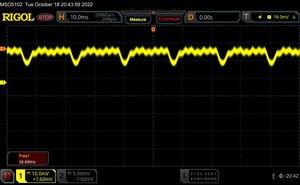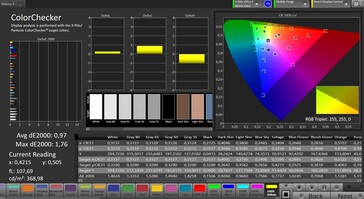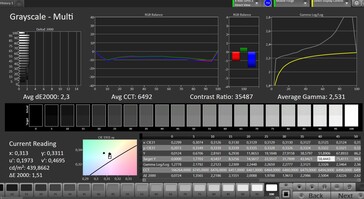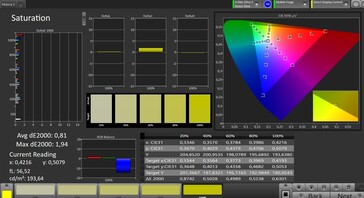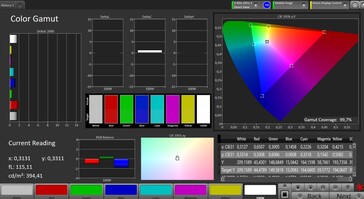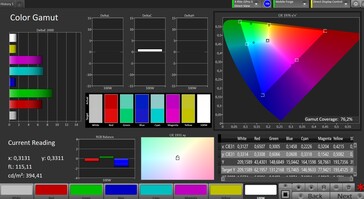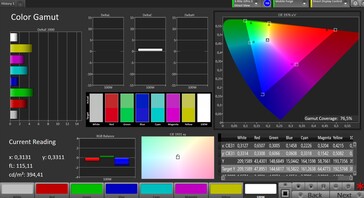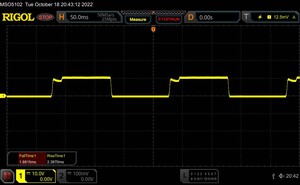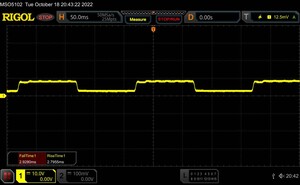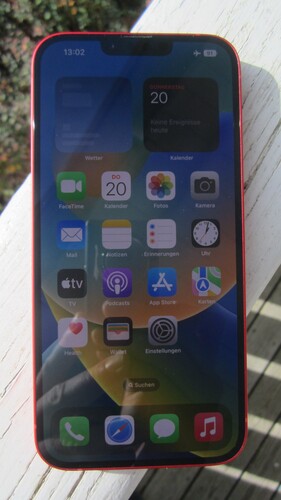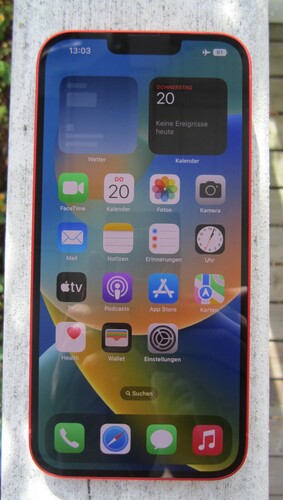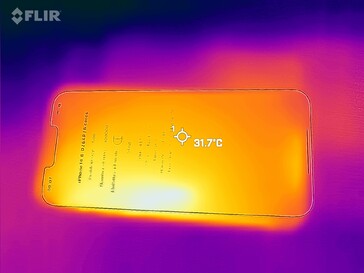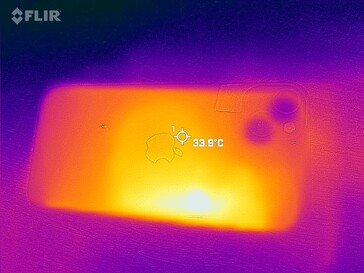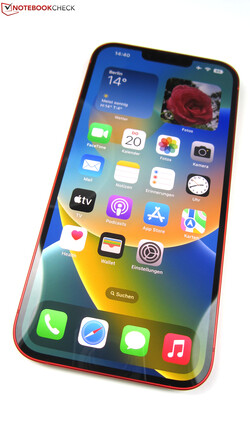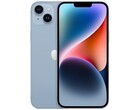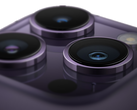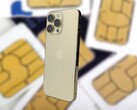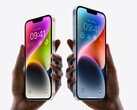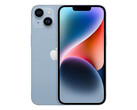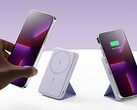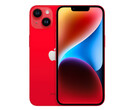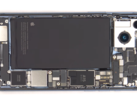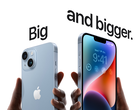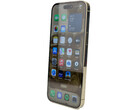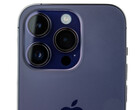Apple iPhone 14 Plus smartphone review - Better than the iPhone 14 with a bigger display?
With the iPhone 14 Plus, Apple tries to appeal to users who desire an iPhone with a big display. In the past, this feature was exclusive to the more expensive Pro models. They were the only ones to include 6.7-inch devices, while the standard iPhone was limited to 6.1 inches diagonally.
The 6.7-inch iPhone 14 Plus is here to shake things up. Like the iPhone 13 Mini, it occupies its own niche, but with the opposite approach. Instead of miniaturizing everything, the focus is on providing as much screen space for multimedia content as possible.
Since they are almost identical excluding the form factor, the iPhone 14 Plus can be seen as an XXL version of the iPhone 14. The only differences are related to the display and battery. With a resolution of 2778 x 1284 pixels, the iPhone 14 Plus has a slightly higher resolution compared to the iPhone 14 (2532 x 1170 pixels), which will be fairly hard to notice during daily use.
The main advantage of the iPhone 14 Plus over the iPhone 14 is its bigger battery. Like the iPhone 14 Pro Max, it comes with a 4323-mAh battery for a significantly better battery life than the iPhone 14 with its 3279-mAh battery.
Potential Competitors in Comparison
Rating | Date | Model | Weight | Drive | Size | Resolution | Price |
|---|---|---|---|---|---|---|---|
| 88.7 % v7 (old) | 10 / 2022 | Apple iPhone 14 Plus A15, A15 GPU 5-Core | 203 g | 128 GB NVMe | 6.70" | 2778x1284 | |
| 89.2 % v7 (old) | 10 / 2022 | Apple iPhone 14 A15, A15 GPU 5-Core | 172 g | 128 GB NVMe | 6.10" | 2532x1170 | |
| 89.2 % v7 (old) | 04 / 2022 | Google Pixel 6 Pro Tensor, Mali-G78 MP20 | 210 g | 128 GB UFS 3.1 Flash | 6.70" | 3120x1440 | |
| 89.3 % v7 (old) | 10 / 2022 | Motorola Edge 30 Ultra SD 8+ Gen 1, Adreno 730 | 198.5 g | 256 GB UFS 3.1 Flash | 6.67" | 2400x1080 | |
| 89.4 % v7 (old) | 03 / 2022 | Samsung Galaxy S22 Ultra 5G Exynos 2200, Xclipse 920 | 228 g | 128 GB UFS 3.1 Flash | 6.80" | 3088x1440 | |
| 87.6 % v7 (old) | 02 / 2022 | Xiaomi 12 Pro SD 8 Gen 1, Adreno 730 | 204 g | 256 GB UFS 3.1 Flash | 6.73" | 3200x1440 |
Case - Apple's Most Lightweight 6.7-Inch Smartphone
The Apple iPhone 14 Plus is available in five colors. In addition to black, white, and red, there are also blue and purple models available. With 7.8 mm (0.31 in), the Apple smartphone is as flat as the iPhone 14 and due to its larger form factor, it weighs around 30 grams more (1.09 oz). At 203 grams (7.16 oz) in total, it feels significantly lighter than its 6.7-inch, stainless steel-framed sibling iPhone 14 Pro Max at 240 grams (8.47 oz).
As per usual, Apple does not compromise in terms of the haptics or build quality. The workmanship of the case is excellent and it is very resistant to twisting from the corners. Due to the greater overall display area, the relative size of the iPhone 14 Plus' notch is smaller compared to the iPhone 14.
Apple's Ceramic Shield protects the front and back from scratches and cracks. The iPhone 14 Plus is dust- and waterproof as specified by IP68. According to Apple, it can survive a 30-minute dive at a depth of up to 6 meters without any damage.
The European version of the iPhone 14 Plus has a nano SIM card slot. It can be used in parallel with the integrated eSIM. By contrast, the US models use dual eSIMs with no physical slots.
Connectivity - Same Base Price as the iPhone 13 Pro
The iPhone 14 Plus comes in 3 storage configurations. With 128 GB of NVMe storage, it can be purchased for 899 USD directly from Apple. The 256-GB version costs 999 USD and the largest 512-GB model 1,199 USD.
This pushes the iPhone 14 Plus into a price segment that used to be exclusive to the Pro models. The iPhone 13 Pro, which unlike the iPhone 13 is no longer available to purchase on Apple's official store, also had a base price of 899 USD at the time of its release in 2021.
The features of the iPhone 14 Plus include NFC, MagSafe, UWB, and Bluetooth 5.3. Like all iPhone 14 models, it uses Apple's proprietary Lightning connector for charging and data transfers, which can reach up to 480 Mb/s for speeds that are comparable to USB 2.0.
Software - iOS 16 for the Apple Smartphone
With every new iPhone generation, a new version of Apple's iOS tends to arrive as well. In this case, the iPhone 14 Plus comes with iOS 16, which includes new features such as a customizable lock screen, an improved focus mode, and retroactive editing of previously sent messages. The update to iOS 16.1 also introduces the shared photo library that allows family members and friends to manage their photos collectively. A list of all new iOS 16 features can be found here.
The most exciting new features of iOS 16, the Dynamic Island and the always-on display, are reserved for the Pro models.
Communication and GNSS - Wi-Fi 6 and Emergency SOS
The iPhone 14 Plus shines with a wide range of supported frequencies, which should result in a good signal regardless of your location. The US models go even further by giving users access to the fast 5G mmWave standard and satellite emergency calls. The latter is only available in the US and Canada as of this writing, although support for more countries including Germany is planned for the end of the year according to rumors.
Crash detection is enabled by default no matter where you are located. This feature measures acceleration forces and automatically calls emergency services in case of an accident.
In terms of the Wi-Fi, the iPhone 14 Plus communicates via Wi-Fi 6 through its 2 antennas and achieves good transfer rates in conjunction with our reference router Asus ROG Rapture GT-AXE11000. Even though it has the exact same Wi-Fi as the iPhone 14, the 6.7-inch device is slightly slower than its smaller sibling in our testing. Furthermore, the transfer rates are not quite as consistent.
The iPhone 14 Plus locates the user with the help of the satellite networks GPS, GLONASS, Galileo, QZSS, and BeiDou. The satellite uplink is quickly established both indoors and outdoors with an accuracy of within around 3 meters (~10 ft).
Similarly, the Apple phone fares well in a real-world navigation task. The iPhone 14 Plus is essentially records our bike ride precisely as the fitness smartwatch Garmin Venu 2, which we took along with us for comparison purposes.
Telephony and Call Quality
The iPhone 14 Plus offers a good call quality and clearly transmits voices even in louder environments. Although ambient noise can occasionally make their way into the call, they are then quickly and reliably filtered out. While the clarity remains high in hands-free mode, our voice sounds somewhat quiet unless we speak directly into the microphone.
The iPhone 14 Plus also supports VoLTE and Wi-Fi calling. An eSIM can be used in parallel with the nano SIM card. Since the US models lack a SIM slot, dual SIM mode is only possible with two eSIMs.
Cameras - Dual Camera with iPhone Pro Genes
At first glance, not much appears to have changed in terms of the dual camera setup of the iPhone 14 models compared to the iPhone 13. The 12-MP main camera did receive a major upgrade, however, since it is now identical to that of the iPhone 13 Pro. This increases the pixel size from 1.7 to 1.9 µm. Additionally, the change from a f/1.6 to a f/1.5 aperture guarantees a better light yield.
The selfie camera has also been upgraded. It also captures more light than the front camera of the iPhone 13 (f/1.9 vs. f/2.2). Additionally, it now features an autofocus for even sharper pictures, particularly at close ranges.
The main camera of the iPhone 14 Plus comes with optical image stabilization and captures excellent photos that shine with natural colors, a high dynamic range, and a high level of detail.
Under good lighting conditions, the images are virtually indistinguishable from those of the iPhone 13. However, under low-light conditons, the advantages of the Apple Photonic Engine become immediately apparent. Thanks to the image processing engine, pictures captured with the iPhone 14 Plus retain many details and rich colors even in dark scenes. The 12-MP ultra-wide camera does not have access to image stabilization, but still produces solid results, even if it cannot quite match the main camera in terms of the image quality.
Video recording also benefits from incremental, generational improvements. The cinema mode, which was previously limited to Full HD, now supports 4K at 24 or 30 frames per second. Additionally, an action mode is now available and able to electronically stabilize videos taken with the main or ultra-wide camera. While this works surprisingly well in practice, it still does not make the iPhone a real GoPro replacement, since action mode videos tend to look fairly grainy.
Image comparison
Choose a scene and navigate within the first image. One click changes the position on touchscreens. One click on the zoomed-in image opens the original in a new window. The first image shows the scaled photograph of the test device.
Tageslicht-Aufnahme 1Tageslicht-Aufnahme 2UltraweitwinkelLowlight-AufnahmeIn our test lab, the main camera shows its ability to very accurately capture colors under ideal lighting. That being said, the mid-range of the grayscale as well as some green and blue shades deviate somewhat far from their ideal values. The color accuracy remains high even at 1 Lux. However, the main camera cannot capture the test chart with a sufficient degree of sharpness in this scenario.
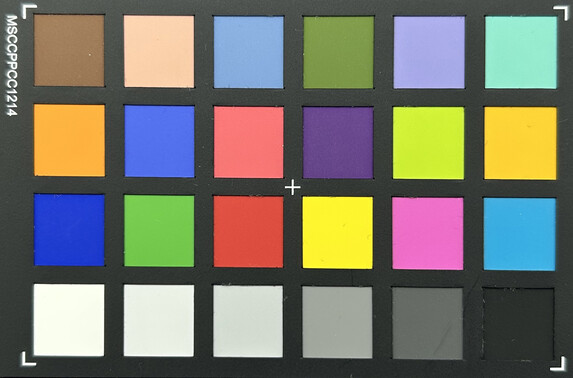
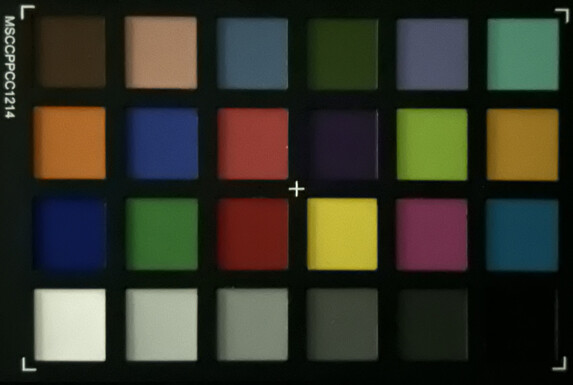
Accessories and Warranty - 12-Month Warranty and Extended AppleCare+
Aside from the iPhone 14 Plus itself, the flat package also includes a USB cable (USB-C to Lightning), a SIM tool, an Apple sticker, a quick-start guide, and warranty information. On its official store, Apple has a wide variety of accessories such as bumpers, chargers, and headphones on offer.
The standard, limited 12-month warranty applies in the US. The warranty can be extended via the insurance plan AppleCare+, which can be paid monthly with an indefinite coverage or as a one-time payment for 2 years. Regardless of the payment option, AppleCare+ covers an unlimited number of accidental damage repairs.
Input Devices & Handling - XXL Display With 60 Hz
Using the iPhone 14 Plus feels very precise and responsive. Due to the 60-Hz screen, navigating the device does not feel quite as smooth as on the Pro models with a 120-Hz screen. While it shares this drawback with the iPhone 14, our test model benefits from larger symbols and text. In this regard, the larger screen can be a real advantage for frequent use. However, using the phone with one hand remains difficult despite the one-handed mode being enabled ex-factory (swiping down from the bottom edge).
The iPhone 14 Plus does not come with a fingerprint sensor. This makes facial recognition via Face ID the only supported biometric authentication method. Thanks to the use of a 3D camera, it is very reliable and considered secure. Thanks to the integrated IR sensor, the smartphone can be unlocked via Face ID even in the dark.
Display - 800 Nit OLED Panel With HDR10 and Dolby Vision
The 6.7-inch Super Retina XDR OLED display of the iPhone 14 Plus has a native resolution of 2778 x 1284 pixels and a fixed refresh rate of 60 Hz. While the pixel density is slightly lower compared to the iPhone 14 (2532 x 1170 pixels), the display is still very sharp. HDR10 and Dolby Vision are supported.
We measured an average brightness of 800.1 nits when displaying a purely white image with the ambient light sensor enabled, which matches the manufacturer's claims almost exactly.
The iPhone 14 Plus very likely uses DC dimming to control its display brightness. Since Apple does not specify how controlling the display's brightness functions, we cannot be certain. In any case, the display flickers at a consistent 59 Hz at all the brightness settings we tested. Unlike displays that use PWM (pulse-width modulation) to control the brightness, which usually results in heavily fluctuating frequencies, the consistent flickering of the iPhone 14 Plus' screen should result in significantly less eyestrain and not be an issue even for sensitive users.
| |||||||||||||||||||||||||
Brightness Distribution: 97 %
Center on Battery: 797 cd/m²
Contrast: ∞:1 (Black: 0 cd/m²)
ΔE ColorChecker Calman: 0.97 | ∀{0.5-29.43 Ø4.81}
ΔE Greyscale Calman: 2.3 | ∀{0.09-98 Ø5.1}
99.7% sRGB (Calman 2D)
Gamma: 2.531
CCT: 6492 K
| Apple iPhone 14 Plus OLED, 2778x1284, 6.7" | Apple iPhone 14 OLED, 2532x1170, 6.1" | Google Pixel 6 Pro LTPO-OLED, 3120x1440, 6.7" | Motorola Edge 30 Ultra pOLED, 2400x1080, 6.7" | Samsung Galaxy S22 Ultra 5G Dynamic AMOLED, 3088x1440, 6.8" | Xiaomi 12 Pro AMOLED, 3200x1440, 6.7" | |
|---|---|---|---|---|---|---|
| Screen | -12% | 3% | 0% | 13% | -5% | |
| Brightness middle (cd/m²) | 797 | 835 5% | 794 0% | 1020 28% | 1077 35% | 959 20% |
| Brightness (cd/m²) | 800 | 841 5% | 801 0% | 1020 28% | 1093 37% | 977 22% |
| Brightness Distribution (%) | 97 | 97 0% | 97 0% | 96 -1% | 97 0% | 96 -1% |
| Black Level * (cd/m²) | ||||||
| Colorchecker dE 2000 * | 0.97 | 1.05 -8% | 0.9 7% | 1 -3% | 1.2 -24% | 1.1 -13% |
| Colorchecker dE 2000 max. * | 1.76 | 2.81 -60% | 2.2 -25% | 2.8 -59% | 2 -14% | 3.1 -76% |
| Greyscale dE 2000 * | 2.3 | 2.6 -13% | 1.5 35% | 2.1 9% | 1.3 43% | 1.9 17% |
| Gamma | 2.531 87% | 2.034 108% | 2.23 99% | 2.29 96% | 2.37 93% | 2.22 99% |
| CCT | 6492 100% | 6616 98% | 6654 98% | 6502 100% | 6526 100% | 6498 100% |
* ... smaller is better
Screen Flickering / PWM (Pulse-Width Modulation)
| Screen flickering / PWM detected | 59 Hz | ||
The display backlight flickers at 59 Hz (worst case, e.g., utilizing PWM) . The frequency of 59 Hz is very low, so the flickering may cause eyestrain and headaches after extended use. In comparison: 53 % of all tested devices do not use PWM to dim the display. If PWM was detected, an average of 8255 (minimum: 5 - maximum: 343500) Hz was measured. | |||
Measurements at a fixed zoom level and various brightness settings
The iPhone 14 Plus adjusts its colors using True Tone for a homogenous visual experience in different ambient light conditions. Since True Tone constantly changes the colors, we have to disable the feature prior to our CalMAN test. Even without True Tone, the image quality of the display is excellent.
Display Response Times
| ↔ Response Time Black to White | ||
|---|---|---|
| 4 ms ... rise ↗ and fall ↘ combined | ↗ 2 ms rise | |
| ↘ 2 ms fall | ||
| The screen shows very fast response rates in our tests and should be very well suited for fast-paced gaming. In comparison, all tested devices range from 0.1 (minimum) to 240 (maximum) ms. » 14 % of all devices are better. This means that the measured response time is better than the average of all tested devices (20.4 ms). | ||
| ↔ Response Time 50% Grey to 80% Grey | ||
| 6 ms ... rise ↗ and fall ↘ combined | ↗ 3 ms rise | |
| ↘ 3 ms fall | ||
| The screen shows very fast response rates in our tests and should be very well suited for fast-paced gaming. In comparison, all tested devices range from 0.165 (minimum) to 636 (maximum) ms. » 17 % of all devices are better. This means that the measured response time is better than the average of all tested devices (31.9 ms). | ||
Thanks to its bright display and its great viewing angles, the iPhone 14 Plus is well suited to outdoor use. The screen content still remains easily discernible even under direct sunlight for the most part, although reflections may adversely affect the experience. In contrast, users should expect no problems when using the smartphone in the shade.
Performance - 5-Core GPU of the iPhone 13 Pro
Unlike the Pro models, the iPhone 14 Plus does not come with the brand-new Apple A16 Bionic and instead uses the A15 Bionic SoC from the iPhone 13 generation. The performance has still been improved slightly. The A15 Bionic inside the iPhone 14 Plus is identical to that of the iPhone 13 Pro. Instead of a 4-core GPU, it now has a 5-core GPU, however. The iPhone 14 uses the same setup.
In the synthetic benchmarks, the iPhone 14 Plus and the iPhone 14 are some of the fastest smartphones currently available. In order to beat Apple's lineup in AnTuTu v9, it takes a flagship in the vein of a Xiaomi 12 Pro (Snapdragon 8 Gen 1) or a Motorola Edge 30 Ultra (Snapdragon 8+ Gen 1).
Thanks to its additional GPU core, the iPhone 14 Plus performs the same as the iPhone 13 Pro in our graphics benchmarks. Competitors are only faster in the GFXBench onscreen tests due to the Apple's limited refresh rate of 60 Hz. The Motorola Edge 30 Ultra comes closest to the iPhone 14 Plus in terms of the graphics performance, although in order to do so, it has to summon the full power of the fastest Android SoC available, the Snapdragon 8+ Gen 1. Even this is insufficient when it comes to the browser benchmarks, however, since no Android phone is currently able to match Apple in this regard.
GFXBench (DX / GLBenchmark) 2.7: T-Rex Onscreen | 1920x1080 T-Rex Offscreen
GFXBench 3.0: on screen Manhattan Onscreen OGL | 1920x1080 1080p Manhattan Offscreen
GFXBench 3.1: on screen Manhattan ES 3.1 Onscreen | 1920x1080 Manhattan ES 3.1 Offscreen
GFXBench: on screen Car Chase Onscreen | 1920x1080 Car Chase Offscreen | on screen Aztec Ruins High Tier Onscreen | 2560x1440 Aztec Ruins High Tier Offscreen | on screen Aztec Ruins Normal Tier Onscreen | 1920x1080 Aztec Ruins Normal Tier Offscreen
| 3DMark / Wild Life Extreme Unlimited | |
| Apple iPhone 14 Plus | |
| Apple iPhone 14 | |
| Motorola Edge 30 Ultra | |
| Xiaomi 12 Pro | |
| Google Pixel 6 Pro | |
| Samsung Galaxy S22 Ultra 5G | |
| 3DMark / Wild Life Extreme | |
| Apple iPhone 14 | |
| Apple iPhone 14 Plus | |
| Motorola Edge 30 Ultra | |
| Xiaomi 12 Pro | |
| Samsung Galaxy S22 Ultra 5G | |
| Google Pixel 6 Pro | |
| 3DMark / Wild Life Unlimited Score | |
| Apple iPhone 14 | |
| Apple iPhone 14 Plus | |
| Motorola Edge 30 Ultra | |
| Xiaomi 12 Pro | |
| Samsung Galaxy S22 Ultra 5G | |
| Google Pixel 6 Pro | |
| GFXBench (DX / GLBenchmark) 2.7 / T-Rex Onscreen | |
| Motorola Edge 30 Ultra | |
| Xiaomi 12 Pro | |
| Samsung Galaxy S22 Ultra 5G | |
| Google Pixel 6 Pro | |
| Apple iPhone 14 | |
| Apple iPhone 14 Plus | |
| GFXBench (DX / GLBenchmark) 2.7 / T-Rex Offscreen | |
| Motorola Edge 30 Ultra | |
| Apple iPhone 14 | |
| Apple iPhone 14 Plus | |
| Xiaomi 12 Pro | |
| Samsung Galaxy S22 Ultra 5G | |
| Google Pixel 6 Pro | |
| GFXBench 3.0 / Manhattan Onscreen OGL | |
| Motorola Edge 30 Ultra | |
| Xiaomi 12 Pro | |
| Samsung Galaxy S22 Ultra 5G | |
| Google Pixel 6 Pro | |
| Apple iPhone 14 | |
| Apple iPhone 14 Plus | |
| GFXBench 3.0 / 1080p Manhattan Offscreen | |
| Apple iPhone 14 | |
| Xiaomi 12 Pro | |
| Apple iPhone 14 Plus | |
| Motorola Edge 30 Ultra | |
| Samsung Galaxy S22 Ultra 5G | |
| Google Pixel 6 Pro | |
| GFXBench 3.1 / Manhattan ES 3.1 Onscreen | |
| Motorola Edge 30 Ultra | |
| Xiaomi 12 Pro | |
| Samsung Galaxy S22 Ultra 5G | |
| Apple iPhone 14 | |
| Apple iPhone 14 Plus | |
| Google Pixel 6 Pro | |
| GFXBench 3.1 / Manhattan ES 3.1 Offscreen | |
| Motorola Edge 30 Ultra | |
| Apple iPhone 14 | |
| Apple iPhone 14 Plus | |
| Xiaomi 12 Pro | |
| Samsung Galaxy S22 Ultra 5G | |
| Google Pixel 6 Pro | |
| GFXBench / Car Chase Onscreen | |
| Motorola Edge 30 Ultra | |
| Apple iPhone 14 | |
| Apple iPhone 14 Plus | |
| Samsung Galaxy S22 Ultra 5G | |
| Xiaomi 12 Pro | |
| Google Pixel 6 Pro | |
| GFXBench / Car Chase Offscreen | |
| Apple iPhone 14 | |
| Apple iPhone 14 Plus | |
| Motorola Edge 30 Ultra | |
| Xiaomi 12 Pro | |
| Samsung Galaxy S22 Ultra 5G | |
| Google Pixel 6 Pro | |
| GFXBench / Aztec Ruins High Tier Onscreen | |
| Motorola Edge 30 Ultra | |
| Apple iPhone 14 | |
| Apple iPhone 14 Plus | |
| Google Pixel 6 Pro | |
| Samsung Galaxy S22 Ultra 5G | |
| Xiaomi 12 Pro | |
| GFXBench / Aztec Ruins High Tier Offscreen | |
| Motorola Edge 30 Ultra | |
| Apple iPhone 14 Plus | |
| Apple iPhone 14 | |
| Xiaomi 12 Pro | |
| Google Pixel 6 Pro | |
| Samsung Galaxy S22 Ultra 5G | |
| GFXBench / Aztec Ruins Normal Tier Onscreen | |
| Motorola Edge 30 Ultra | |
| Apple iPhone 14 | |
| Apple iPhone 14 Plus | |
| Xiaomi 12 Pro | |
| Google Pixel 6 Pro | |
| Samsung Galaxy S22 Ultra 5G | |
| GFXBench / Aztec Ruins Normal Tier Offscreen | |
| Apple iPhone 14 Plus | |
| Motorola Edge 30 Ultra | |
| Apple iPhone 14 | |
| Xiaomi 12 Pro | |
| Google Pixel 6 Pro | |
| Samsung Galaxy S22 Ultra 5G | |
| Jetstream 2 - 2.0 Total Score | |
| Apple iPhone 14 (Safari 16) | |
| Apple iPhone 14 Plus (Safari 16) | |
| Average Apple A15 Bionic (173.5 - 189.9, n=8) | |
| Average of class Smartphone (13.8 - 387, n=152, last 2 years) | |
| Motorola Edge 30 Ultra (Chrome 105) | |
| Samsung Galaxy S22 Ultra 5G (Chrome 99) | |
| Google Pixel 6 Pro (Chrome 100) | |
| Xiaomi 12 Pro (Chrome 97) | |
| Speedometer 2.0 - Result | |
| Apple iPhone 14 Plus (Safari 16) | |
| Apple iPhone 14 (Safari 16) | |
| Average Apple A15 Bionic (228 - 347, n=8) | |
| Average of class Smartphone (15.2 - 585, n=135, last 2 years) | |
| Google Pixel 6 Pro (Chrome 100) | |
| Samsung Galaxy S22 Ultra 5G (Chrome 99) | |
| Motorola Edge 30 Ultra (Chrome 105) | |
| Xiaomi 12 Pro (Chrome 97) | |
| WebXPRT 4 - Overall | |
| Average Apple A15 Bionic (188 - 189, n=3) | |
| Apple iPhone 14 Plus (Safari 16) | |
| Apple iPhone 14 (Safari 16) | |
| Average of class Smartphone (22 - 273, n=145, last 2 years) | |
| Motorola Edge 30 Ultra (Chrome 105) | |
| WebXPRT 3 - Overall | |
| Apple iPhone 14 (Safari 16) | |
| Apple iPhone 14 Plus (Safari 16) | |
| Average Apple A15 Bionic (219 - 279, n=8) | |
| Average of class Smartphone (38 - 347, n=53, last 2 years) | |
| Motorola Edge 30 Ultra (Chrome 105) | |
| Samsung Galaxy S22 Ultra 5G (Chrome 99) | |
| Xiaomi 12 Pro (Chrome 97) | |
| Google Pixel 6 Pro (Chrome 100) | |
| Octane V2 - Total Score | |
| Apple iPhone 14 (Safari 16) | |
| Apple iPhone 14 Plus (Safari 16) | |
| Average Apple A15 Bionic (57143 - 65969, n=8) | |
| Average of class Smartphone (2228 - 100368, n=202, last 2 years) | |
| Google Pixel 6 Pro (Chrome 100) | |
| Motorola Edge 30 Ultra (Chrome 105) | |
| Samsung Galaxy S22 Ultra 5G (Chrome 99) | |
| Xiaomi 12 Pro (Chrome 97) | |
| Mozilla Kraken 1.1 - Total | |
| Xiaomi 12 Pro (Chrome 97) | |
| Samsung Galaxy S22 Ultra 5G (Chrome 99) | |
| Average of class Smartphone (277 - 28190, n=156, last 2 years) | |
| Motorola Edge 30 Ultra (Chrome 105) | |
| Google Pixel 6 Pro (Chrome 100) | |
| Apple iPhone 14 Plus (Safari 16) | |
| Apple iPhone 14 (Safari 16) | |
| Average Apple A15 Bionic (414 - 507, n=8) | |
* ... smaller is better
Gaming - Powerful Gaming Smartphone
Thanks to its enormous performance potential, the iPhone 14 Plus effortlessly runs all current titles smoothly even at the maximum detail settings. PUBG Mobile, for example, runs buttery smooth at the maximum "Ultra HD/Maximum" setting. As a result, users will not have to worry about being able to run upcoming games due to a lack of performance
Since our test app Gamebench does not yet support iOS 16 at this time, we are unfortuantely unable to show gaming benchmarks here.
Emissions - Throttling Under Continuous Load
Temperature
With up to 36.2 °C (97.16 °F) during use, the iPhone 14 Plus only becomes lukewarm. When pushing the smartphone for a prolonged period of time, hotspots can reach more than 40 °C (104 °F). We observe throttling under continuous load, as demonstrated by the 3DMark Wild Life benchmarks.
Even after the first couple of loops, the performance drops in both Wild Life test scenarios. The total performance deficit amounts to over 30 % in both cases. Interestingly, the iPhone 14 performs much better in our stress test despite being equipped with the same SoC, while having access to less surface area for dissipating heat. This is not a major issue overall, since even a throttled iPhone 14 Plus can deliver an abundance of performance.
(±) The maximum temperature on the upper side is 40.7 °C / 105 F, compared to the average of 35.2 °C / 95 F, ranging from 21.9 to 247 °C for the class Smartphone.
(±) The bottom heats up to a maximum of 43.1 °C / 110 F, compared to the average of 33.9 °C / 93 F
(+) In idle usage, the average temperature for the upper side is 23.1 °C / 74 F, compared to the device average of 32.9 °C / 91 F.
3DMark Wild Life Stress Test
| 3DMark | |
| Wild Life Stress Test Stability | |
| Apple iPhone 14 | |
| Apple iPhone 14 Plus | |
| Motorola Edge 30 Ultra | |
| Samsung Galaxy S22 Ultra 5G | |
| Xiaomi 12 Pro | |
| Google Pixel 6 Pro | |
| Wild Life Extreme Stress Test | |
| Apple iPhone 14 | |
| Apple iPhone 14 Plus | |
| Motorola Edge 30 Ultra | |
| Samsung Galaxy S22 Ultra 5G | |
| Google Pixel 6 Pro | |
| Xiaomi 12 Pro | |
Speakers
The stereo speakers of the iPhone 14 Plus consist of a speaker on the bottom and a hybrid speaker/earpiece above the notch. The two sound membranes can reach up to 79.8 dB(A) and offer a sound that is characteristic for smartphones with an emphasis on mids and treble and a lack of bass.
Attaching external audio devices to the Apple phone results in a better sound. This can be accomplished via a wired Lightning adapter or wireless Bluetooth 5.3 devices. Since the iPhone does not speak aptX, users should ensure that their audio device supports the AAC codec.
Apple iPhone 14 Plus audio analysis
(±) | speaker loudness is average but good (79.8 dB)
Bass 100 - 315 Hz
(-) | nearly no bass - on average 16.7% lower than median
(±) | linearity of bass is average (8.7% delta to prev. frequency)
Mids 400 - 2000 Hz
(+) | balanced mids - only 3.3% away from median
(+) | mids are linear (3.6% delta to prev. frequency)
Highs 2 - 16 kHz
(+) | balanced highs - only 4.5% away from median
(+) | highs are linear (4% delta to prev. frequency)
Overall 100 - 16.000 Hz
(±) | linearity of overall sound is average (15.6% difference to median)
Compared to same class
» 3% of all tested devices in this class were better, 3% similar, 94% worse
» The best had a delta of 12%, average was 35%, worst was 134%
Compared to all devices tested
» 22% of all tested devices were better, 4% similar, 74% worse
» The best had a delta of 4%, average was 24%, worst was 134%
Samsung Galaxy S22 Ultra 5G audio analysis
(+) | speakers can play relatively loud (90.2 dB)
Bass 100 - 315 Hz
(-) | nearly no bass - on average 24.4% lower than median
(±) | linearity of bass is average (8.8% delta to prev. frequency)
Mids 400 - 2000 Hz
(±) | higher mids - on average 6.3% higher than median
(+) | mids are linear (4.8% delta to prev. frequency)
Highs 2 - 16 kHz
(±) | higher highs - on average 5.6% higher than median
(+) | highs are linear (4.1% delta to prev. frequency)
Overall 100 - 16.000 Hz
(±) | linearity of overall sound is average (18.5% difference to median)
Compared to same class
» 18% of all tested devices in this class were better, 10% similar, 72% worse
» The best had a delta of 12%, average was 35%, worst was 134%
Compared to all devices tested
» 40% of all tested devices were better, 8% similar, 52% worse
» The best had a delta of 4%, average was 24%, worst was 134%
Battery Life - Smartphone With Great Runtimes
Energy Consumption
The iPhone 14 Plus is energy-efficent during use, although competitors are at least as economical overall. Compared to the iPhone 14, our test device draws slightly more power, which can likely be attributed to the larger display.
| Off / Standby | |
| Idle | |
| Load |
|
Key:
min: | |
| Apple iPhone 14 Plus 4323 mAh | Apple iPhone 14 3279 mAh | Google Pixel 6 Pro 5003 mAh | Motorola Edge 30 Ultra 4610 mAh | Samsung Galaxy S22 Ultra 5G 5000 mAh | Xiaomi 12 Pro 4600 mAh | Average Apple A15 Bionic | Average of class Smartphone | |
|---|---|---|---|---|---|---|---|---|
| Power Consumption | 19% | 6% | 1% | 9% | -3% | 2% | -17% | |
| Idle Minimum * (Watt) | 0.7 | 0.6 14% | 0.7 -0% | 0.74 -6% | 0.58 17% | 0.94 -34% | 0.66 ? 6% | 0.856 ? -22% |
| Idle Average * (Watt) | 1.1 | 0.8 27% | 1 9% | 1.84 -67% | 0.71 35% | 1.24 -13% | 1.303 ? -18% | 1.419 ? -29% |
| Idle Maximum * (Watt) | 1.4 | 1 29% | 1.04 26% | 1.86 -33% | 1.16 17% | 1.34 4% | 1.748 ? -25% | 1.582 ? -13% |
| Load Average * (Watt) | 6.5 | 5.4 17% | 6.87 -6% | 2.75 58% | 7.07 -9% | 5.7 12% | 4.85 ? 25% | 7.18 ? -10% |
| Load Maximum * (Watt) | 9.8 | 9.2 6% | 9.87 -1% | 4.54 54% | 11.32 -16% | 8.12 17% | 7.77 ? 21% | 10.9 ? -11% |
* ... smaller is better
Power Consumption: Geekbench (150 nits)
Power Consumption: GFXBench (150 nits)
Battery Life
Battery life is one of the few categories where the iPhone 14 Plus is able to set itself apart from the iPhone 14. It reaches excellent runtimes that barely any other smartphone can matcht thanks to its 4323-mAh battery. During emulated web browsing it achieves an excellent result of 18 hours and an even more impressive result of over 25 hours during video playback. This makes the iPhone 14 Plus an interesting device for hardcore smartphone users.
Since the iPhone 14 Plus is limited to a maximum charge rate of 20 watts, recharging the battery takes quite a while. With Apple's 20-watt charger, fully recharging an empty battery takes about 2:03 hours. Alternatively, the smartphone can be charged via MagSafe at up to 15 watts or via Qi charging at up to 7.5 watts.
| Apple iPhone 14 Plus 4323 mAh | Apple iPhone 14 3279 mAh | Google Pixel 6 Pro 5003 mAh | Motorola Edge 30 Ultra 4610 mAh | Samsung Galaxy S22 Ultra 5G 5000 mAh | Xiaomi 12 Pro 4600 mAh | |
|---|---|---|---|---|---|---|
| Battery Runtime | -14% | -39% | -19% | -17% | -28% | |
| Reader / Idle (h) | 55.4 | 44.8 -19% | 36.8 -34% | 32.9 -41% | 33.9 -39% | |
| H.264 (h) | 25.3 | 21.1 -17% | 19.8 -22% | 18 -29% | 13.1 -48% | |
| WiFi v1.3 (h) | 18.1 | 16.8 -7% | 11.1 -39% | 14.5 -20% | 14.1 -22% | 12.8 -29% |
| Load (h) | 5.4 | 4.8 -11% | 5.4 0% | 6.8 26% | 5.6 4% |
Pros
Cons
Verdict on the Apple iPhone 14 Plus
Since the Apple iPhone 14 Plus has a lot in common with the iPhone 14, our verdict is very similar. The iPhone 14 Plus, too, is an excellent smartphone and a top choice in terms of the design, build quality, display, camera, battery life, and performance. At the same time, it is the first non-Pro iPhone with a 6.7-inch display.
Compared to the 6.1-inch display of the iPhone 14, the larger size is very apparent during day-to-day use. The battery life is significantly longer and thanks to the 6.7-inch screen, browsing the web, chatting, or navigating the iOS settings can be a better, more comfortable experience.
Although the Apple iPhone 14 Plus is a very good smartphone with excellent battery life, the features do not quite justify the price.
This begs the question: Which type of user is the iPhone 14 Plus actually meant for? Its starting price of 899 USD will likely already dissuade many prospective customers, even though compared to the iPhone 14, a 100-USD premium for a bigger display is still relatively modest. However, Apple is its own toughest competitor and the iPhone 14 Plus does not manage to live up to its price.
The 6.7-inch iPhone 13 Pro Max will likely be the main competitor of the iPhone 14 Plus. While it is very similarly priced, it has a lot more to offer: A 120-Hz display, an additional telephoto lens, and a stainless steel frame are all features the iPhone 14 Plus lacks. Meanwhile, the iPhone 14 Pro Max does everything the iPhone 13 Pro Max does and more, including extras such as the Dynamic Island and the always-on display - albeit for at least 200 USD more than our test model.
Alternatives to the Apple iPhone 14 Plus include the iPhone 13 Pro and the iPhone 14 Pro Max as well as, for example, the Samsung Galaxy S22 Ultra and the Xiaomi 12 Pro.
Price and Availability
The iPhone 14 Plus 128 GB can be purchased directly from Apple for 899 USD. The 256-GB and 512-GB models cost 999 USD and 1199 USD, respectively. Depending on the color variant, cheaper offers may be available from third-party retailers.
Apple iPhone 14 Plus
- 10/25/2022 v7 (old)
Manuel Masiero




